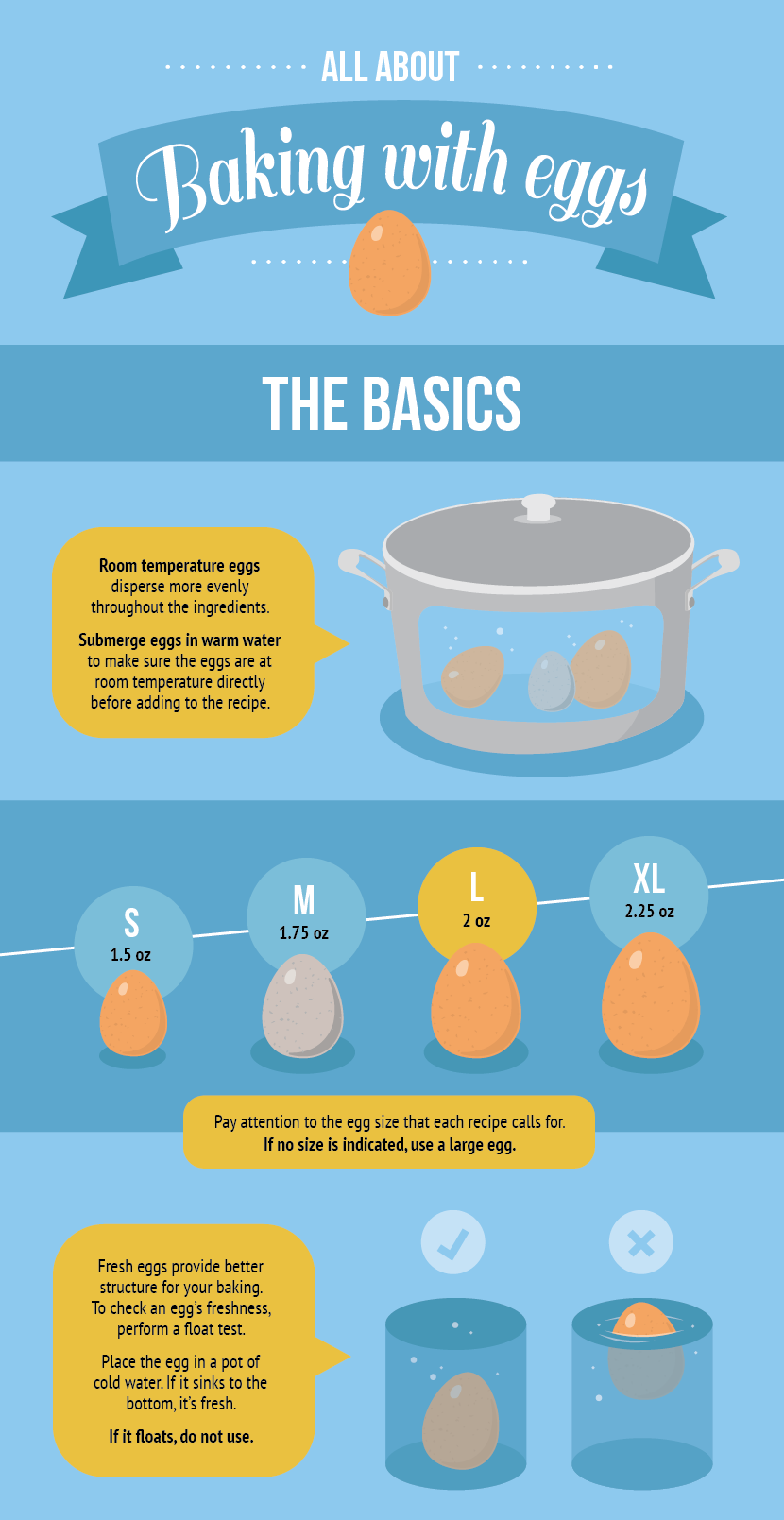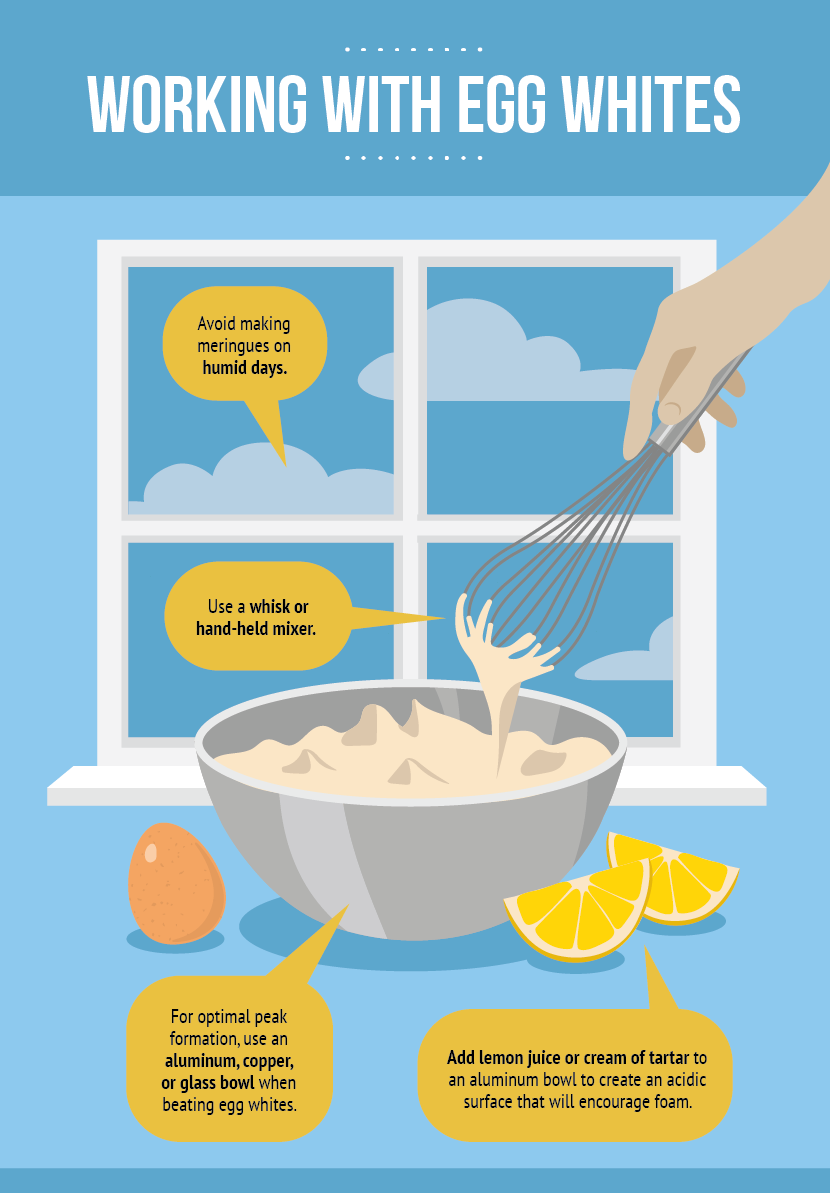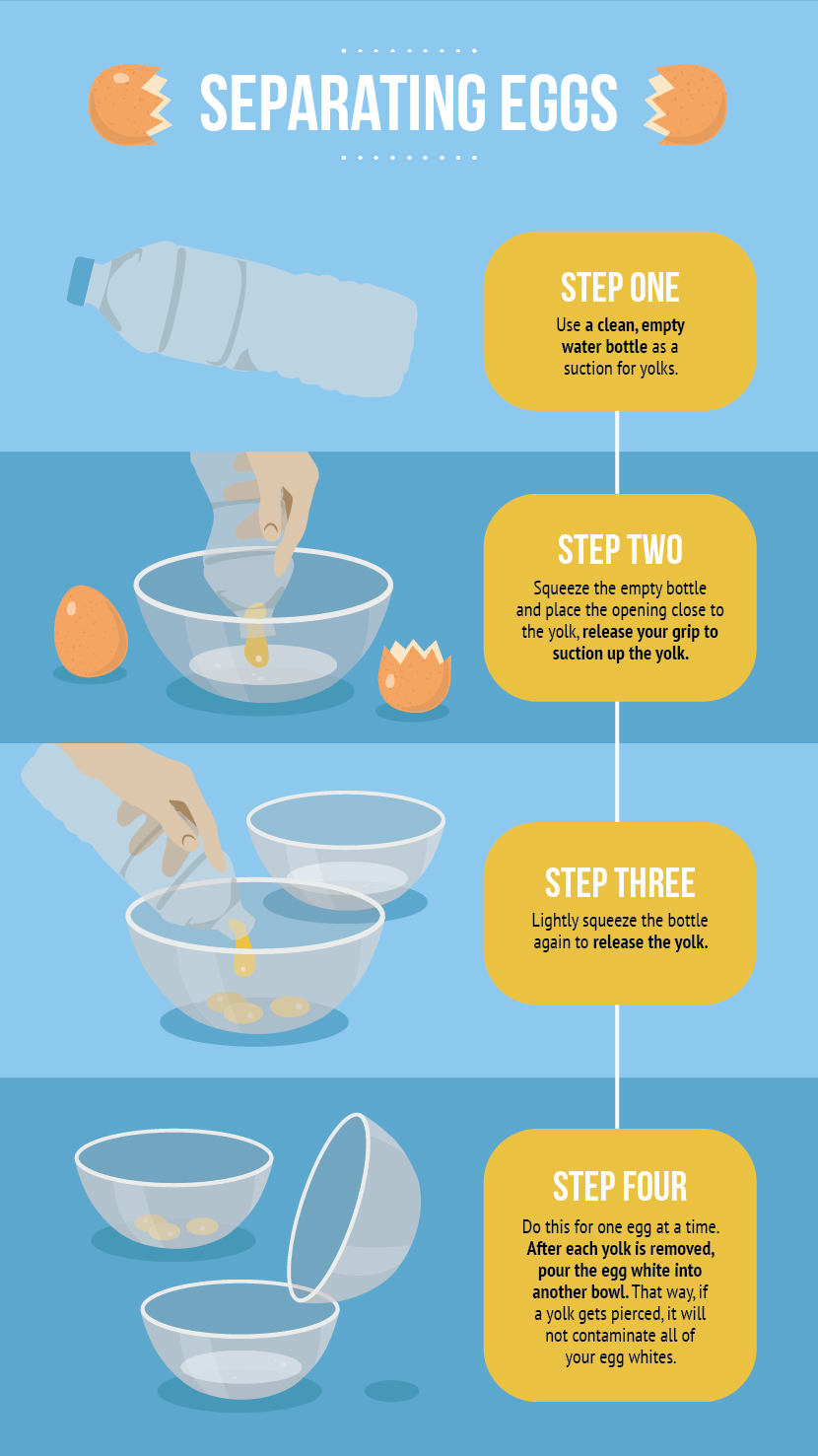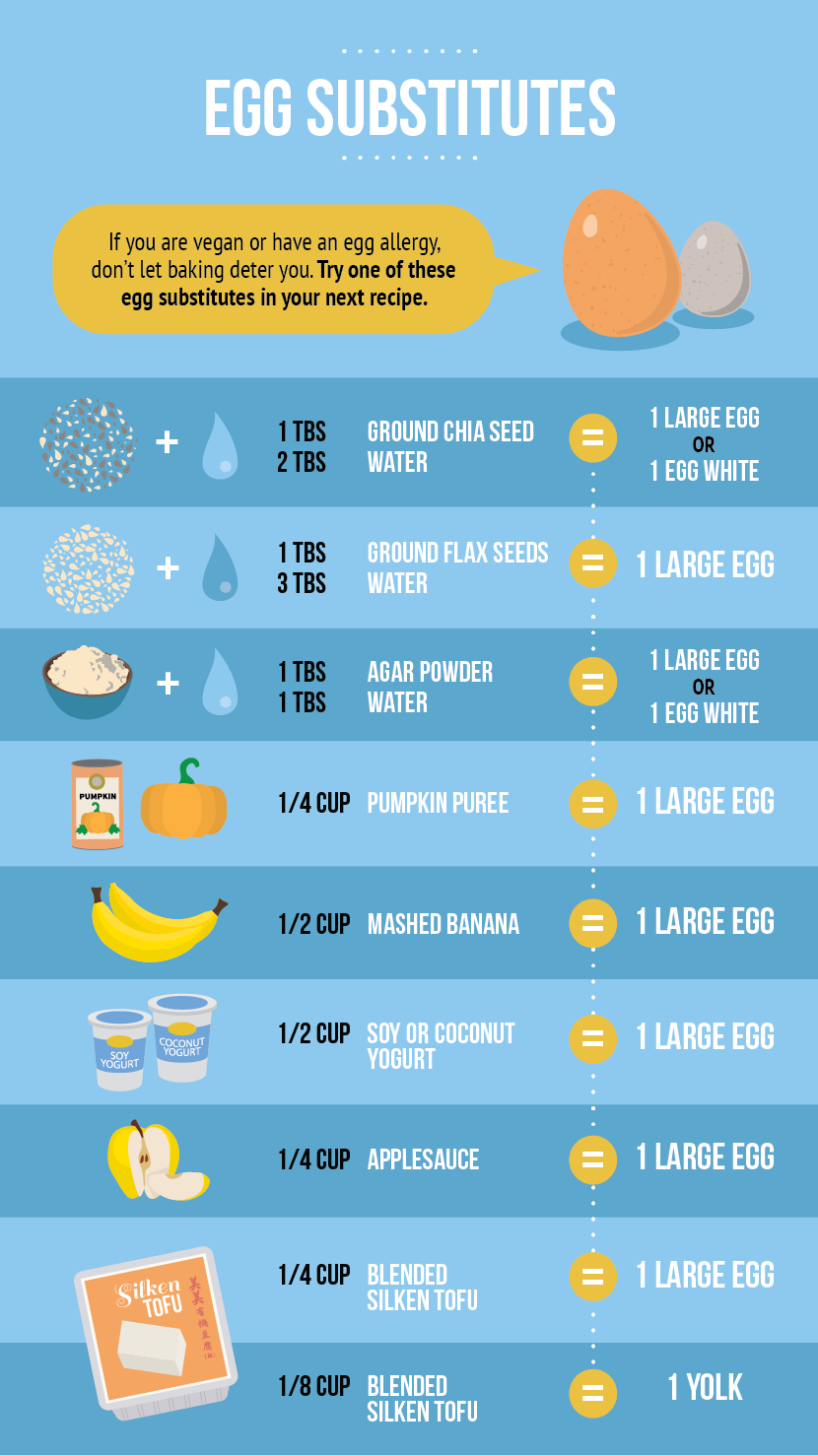All About Baking With Eggs
At first glance, eggs seem awfully simple. But you might be surprised to find that they may be the most complex foods in your kitchen.
They boast a crucial role in baking, offering everything from structure to color.
They also add flavor and thickness, and act as a leavening agent. It’s safe to say that eggs are talented.
Depending on the recipe, egg whites and yolks can be used separately or together.
The chemical constituents of each part have a significant influence on the way ingredients interact with each other.
Because eggs are so versatile and have countless uses, optimal preparation is imperative. Even the smallest slip can impact the finished product.
Luckily, you don’t need to be a professional baker to master the art of baking with eggs.
The key is to keep the following aspects in mind and practice, practice, practice.
You’ll be surprised at what you can accomplish by simply paying attention to the basics.
Temperature
Worrying about the temperature outside the oven might seem silly. However, the temperature of your eggs is worth the worry.
When eggs are at room temperature, they disperse better throughout the ingredients.
This makes it easier to lock in air, creating a desirable, lighter texture. If the eggs are too cold, the finished product may end up extremely dense.
Often, recipes call for eggs at room temperature. To quickly bring eggs, egg whites, or yolks to room temperature, place them in a bowl.
Place the bowl in a pot of warm (not hot) water. After 10 to 15 minutes, your eggs will be at the ideal temperature for baking.

Size
These days, eggs are available in many sizes. For baking, your best bet is to opt for large eggs – nothing more, nothing less.
If a recipe does not indicate an egg size, choose large. Some recipes may call for jumbo or extra-large. If so, adhere to this requirement.
Think of it this way: eggs add liquid to a recipe. The ratio of liquids to solids is essential for the proper chemical reactions to take place.
Using an egg of a different size can easily throw off these reactions.
By sticking to what the recipe asks for, you’ll be more likely to create a successful (and delicious) baked good.
Freshness
Use the freshest eggs possible. Fresh eggs are more acidic and encourage better stabilization of proteins.
This is necessary for maintaining the structural integrity of your finished product.
Fortunately, you don’t need to get cracking to check eggs for freshness. A float test can be performed right in your kitchen. Simply place the egg in a pot or bowl of cold water.
If the egg is fresh, it will sink to bottom of the pot. If the egg is rotten, it will float. The older the egg, the more porous the shell becomes.
Thus, more air filters into the egg and creates larger air cells that lead to floating.
This float test is especially useful if you gathered the eggs straight from your chickens. Likewise, it can come in handy if the carton is missing an expiration date.
Regardless, it never hurts to perform this test before adding eggs straight to your batter. It might be the exact move that can save your batter from the trash.

Proper Separation
When a recipe calls for yolks or whites, thoroughly separating the two is vital. Yolks are high in fat, while the whites are made of water and protein.
For either component to do its job properly, they must stay separate. Otherwise, it will become unusable and negatively impact the recipe.
Keeping the yolk intact is the main goal. The most common traditional method is breaking the egg open along the middle and using each side of the shell as a “cup.”
The yolk is poured back and forth between the “cups,” letting the egg white drop into a bowl below.
Unfortunately, the shell can easily pierce the yolk, bits of the shell might break off, and egg shells are not always the cleanest.
Instead, try a clever hack using a clean, empty plastic water bottle. Carefully break open an egg in a bowl.
Squeeze the bottle and place the opening near the yolk. Next, loosen your grip; the bottle will suck up the yolk. Lightly squeeze again to release the yolk into a second bowl.
Alternatively, you can purchase a novelty egg-separating tool. However, the water bottle trick is the cheapest and easiest option.
To increase the chances of a successful separation, chill the eggs first. The yolks are less likely to break when cold.
To chill eggs, place them in the fridge for half an hour, unless they are already stored there to begin with.
After separation, bring the parts you need to room temperature by placing the bowl in a pot of warm water for 10 minutes.

Egg White Hacks
Baking with egg whites is tricky business. The structural integrity of daintier baked goods depends on them.
To ensure the best preparation, use a glass or aluminum bowl when whipping egg whites. If possible, use a copper bowl; the finish will promote the best peak formation.
You can also add acids such as cream of tartar or lemon juice to an aluminum bowl to help encourage foam formation.
Avoid plastic bowls, as they are likely to retain fats from past recipes.
Every type of recipe warrants a different approach. Pavlova and meringue cookies are best made on cool days with no humidity.
Otherwise, the moisture in the atmosphere can interfere with foam formation. Proper separation of yolk and whites is important, as fat can interrupt the foaming action of whipping.
Separate when chilled and whip at room temperature. This will ensure that enough volume can be produced.
Sugar must be added after the egg whites have successfully formed high peaks.
Making macarons? Move the bowl to check the stiffness of the egg white foam. If it is stiff enough, it will not move.
Pay extra attention when folding the dry ingredients in the egg whites; it must be done thoroughly and properly. A flexible rubber spatula works best.
When making pound cakes, add eggs one at a time. Do not overbeat them.
Otherwise, the batter may overflow and create a crust that is void of that moist exterior that is iconic of pound cake.

Egg Substitutes
When eggs are such a fundamental part of baking, it’s hard to imagine life without them.
However, there are substitutes that can accommodate vegan diets or allergies.
They are also useful if you have run out of eggs but need to complete a recipe.
After all, nothing is worse than starting a recipe only to realize you’re out of eggs.
It also provides a fun opportunity to experiment with diverse ingredients in the kitchen.
Not sure where to start? Check out these popular egg substitute options:
- Chia Seeds: 1 tablespoon ground chia seeds + 2 tablespoon water = 1 egg or 1 egg white. Let sit for 4 to 5 minutes. Mix for a few seconds before adding to recipe
- Flax Seeds: 1 tablespoon finely ground golden flax seeds mixed with 3 tablespoons of water = 1 large egg. After half an hour, the mixture should have a gel-like consistency. Can also be used to replace egg yolks.
- Silken Tofu: ¼ cup blended until smooth = 1 large egg or 1/8 cup = 1 yolk
- Canned Pumpkin Puree: ¼ cup = 1 large egg
- Applesauce: ¼ cup = 1 large egg
- Banana: 1/2 cup mashed banana = 1 large egg
- Coconut or Soy Yogurt: ¼ cup = 1 large egg
- Agar: 1 tablespoon agar powder + 1 tablespoon water = 1 egg white or 1 large egg
- Commercial Egg Replacements: Per packaging
Keep in mind that while these substitutes serve the same purpose as eggs, they might yield slightly different textures, flavors, or colors.
Don’t be afraid to experiment and see what works best for your purposes; you never know what new creation you’ll come up with.
The next time you bake, keep these concepts in mind. These extra bits of knowledge will be a complete game changer for your recipe.
Before you know it, you and your sweet tooth will be basking in perfectly baked goods.
Embed the article on your site

